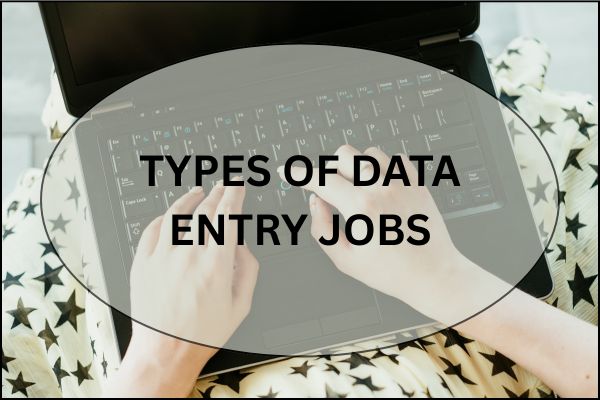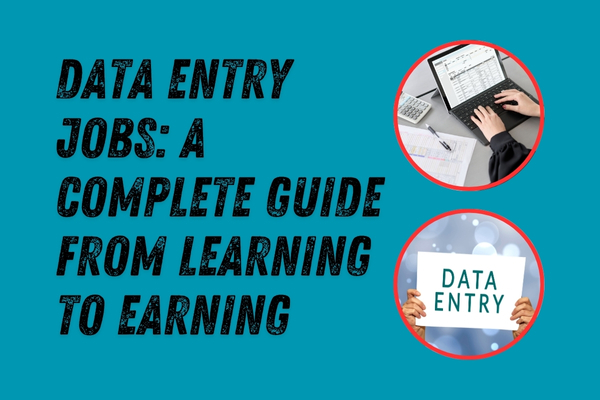Table of Contents
Looking for a simple, flexible way to start earning online? Data entry jobs might be exactly what you need. In this guide, you’ll discover everything — from what data entry jobs are, what skills you need, where to find legitimate work, and how to start earning steadily. Whether you’re a student, a stay-at-home parent, or someone looking for a side income, this post will walk you through the real path to earning through data entry jobs.
What is Data Entry?

Data entry is the process of entering, updating, or managing data in digital systems. This data can be in the form of text, numbers, or even audio files that need to be transcribed. Businesses across the world need people to handle this information.
Some examples of data entry tasks include:
- Typing handwritten documents into Word or Excel
- Transcribing audio recordings
- Inputting customer details into CRM software
- Copy-paste work from one system to another
- Organizing data in spreadsheets
In simple terms, data entry involves handling digital information in a way that makes it accessible and useful for businesses.
Common Types of Data Entry Jobs

When people hear “data entry jobs,” they often assume it’s just one simple role — but in truth, it covers many positions, each requiring different tools, skills, and offering varying income opportunities. Below are the most common types of data entry jobs, along with essential details to help you choose the right one.
1. Online Data Entry
This is among the most popular data entry roles, carried out entirely online. Tasks often include transferring details from scanned files, emails, or PDFs into spreadsheets or CMS platforms—making it ideal for remote professionals.
Monthly Income Potential: ₹15,000 to ₹35,000
Skill Level: Beginner
Tools: Google Sheets, Excel
Scam Risk: Low
Career Growth: Moderate—can lead to virtual assistant or back-office roles.
2. Offline Data Entry
Unlike online roles, offline data entry involves working without an active internet connection. You may be given scanned documents and tasked with entering the information into Word or Excel, then submitting it once you’re back online.Monthly Income Potential: ₹15,000 to ₹30,000
Skill Level: Beginner
Tools: MS Word, Excel
Scam Risk: Low
Career Growth: Moderate—ideal for entry-level earners.
3. Form Filling Jobs
In this job, you’ll input provided data into digital forms such as surveys, applications, or feedback sheets. Precision matters, as errors can lead to disqualified entries.Monthly Income Potential: ₹10,000 to ₹25,000
Skill Level: Beginner
Tools: Internet browser, form software
Scam Risk: Medium—be cautious of jobs that ask for upfront payments.
Career Growth: Low—limited room for advancement.
4. Captcha Entry
Captcha entry involves typing twisted letters and numbers from images to confirm you’re not a robot. Though simple to begin, these jobs pay very little and are often linked to untrustworthy websites.
Monthly Income Potential: ₹5,000 to ₹10,000
Skill Level: Beginner
Tools: Browser, captcha tools
Scam Risk: High—many platforms are known for not paying.
Career Growth: Very low—best avoided if you’re serious about earning.
5. Transcription Jobs
Transcription work requires you to listen to audio recordings and accurately type what’s being said. It can be general or specialized in fields like legal or medical. Strong typing and listening skills can significantly boost your earnings.
Monthly Income Potential: ₹30,000 to ₹70,000; skilled professionals may earn over ₹1 lakh.
Skill Level: Intermediate to advanced
Tools: Express Scribe, oTranscribe, foot pedals
Scam Risk: Medium—watch for fake “training fees”
Career Growth: High—can lead to freelance success or full-time roles.
6. Data Cleaning
Data cleaning is a more technical form of data entry where you review and correct records for mistakes, duplicates, or formatting problems—an essential step before data can be analyzed effectively.
Monthly Income Potential: ₹20,000 to ₹50,000
Skill Level: Intermediate
Tools: Excel, OpenRefine
Scam Risk: Low
Career Growth: High—can evolve into data analyst or quality assurance roles.
7. Image-to-Text Conversion
Image-to-text conversion involves typing out content from scanned or handwritten documents into editable formats such as Word or Google Docs, where both speed and precision matter.
Monthly Income Potential: ₹15,000 to ₹35,000
Skill Level: Beginner to intermediate
Tools: OCR tools, MS Word, Google Docs
Scam Risk: Low
Career Growth: Moderate—often used in archiving and documentation work.
8. Product Listing
In eCommerce, product listing roles involve inputting titles, descriptions, prices, and images into platforms like Amazon, Shopify, or WooCommerce, blending data entry with basic content formatting.
Monthly Income Potential: ₹20,000 to ₹60,000; skilled professionals can earn over ₹1 lakh.
Skill Level: Intermediate
Tools: Amazon Seller Central, Shopify, Excel
Scam Risk: Low
Career Growth: High—can lead to roles in eCommerce management or digital marketing.
While all of these roles fall under the broader category of data entry jobs, they differ significantly in terms of complexity, income potential, and long-term value. Beginners can start with simple roles like online or offline data entry, but those aiming to earn more should consider upskilling into transcription, data cleaning, or product listing.
Skills Needed to Get Jobs in Data Entry

Though data entry roles are often viewed as beginner-level, the right skills can significantly boost your earning potential and help you work more efficiently and accurately. Whether you’re aiming for remote or office-based jobs, these are the essential skills every data entry professional should master:
1. Fast and Accurate Typing
Typing forms the core of nearly all data entry tasks. To perform well, you should target a speed of 40–50 words per minute while maintaining strong accuracy. Clients typically expect clean work with few errors and uniform formatting.
💡 Tip: You can improve your typing speed with free tools like Keybr or TypingTest.
2. Basic Computer Literacy
You don’t have to be highly technical, but being confident with everyday computer tasks is essential. This means:
- Browsing through folders and files
- Creating, modifying, and storing documents
- Working with cloud tools like Google Drive or Dropbox
- Handling basic issues like software glitches
3. Proficiency in MS Office or Google Workspace
Many data entry roles depend on tools like Excel, Google Sheets, Word, or Google Docs—and occasionally PowerPoint. Being able to apply formulas, organize rows and columns, and properly format data can give you a competitive edge.
4. Attention to Detail
A small typo or missing entry can cause serious issues in data tasks. That’s why employers prefer individuals who carefully review their work, keep formatting consistent, and practice habits like data validation.
5. Good Communication Skills
Even if your role is mostly behind the scenes, clear communication with clients or team leads is essential for success.
- Asking clarifying questions
- Responding to feedback professionally
- Writing clean, polite messages via email or chat
6. Time Management
Meeting deadlines is key in data entry roles—managing your schedule, staying focused, and handling urgent tasks efficiently helps maintain both speed and quality.
7. Familiarity with Data Entry Software
Depending on the specific job, you might be required to use specialized tools like:
- OCR software (for image-to-text work)
- CRM platforms (like Salesforce)
- Transcription tools (like Express Scribe or oTranscribe)
Being able to learn new tools quickly is a highly valuable and often overlooked skill in data entry work.
8. Basic English Language Skills
Most data entry jobs involve reading and understanding instructions or text in English. Flawless grammar isn’t necessary, but you should confidently:
- Steer clear of major language errors
- Interpret written instructions
- Grasp the overall meaning
9. Confidentiality & Ethics
Many data entry jobs involve handling sensitive information. Companies expect you to keep data private and follow ethical guidelines—especially in fields like healthcare or finance.
While a degree isn’t required to get started in data entry, combining essential soft skills with basic technical know-how can make you stand out. Begin by improving your typing speed, then practice with spreadsheets to build real-world confidence.
Where to Learn Data Entry Skills

Before diving into data entry jobs, it’s crucial to build the right skills—and the best part is, you can do it without breaking the bank. From typing practice to brushing up on Excel, tons of free or low-cost resources are just a click away online.
Free Platforms to Learn Data Entry Skills
1. Google Workspace Training
If you’re new to tools like Google Sheets and Google Docs (which are used in many data entry jobs), Google offers its own free tutorials on how to use them efficiently. You’ll learn formatting, formulas, shortcuts, and collaboration tools.
2. Typing.com
This site offers completely free typing lessons that help improve speed and accuracy. It’s great for building the most essential skill for data entry work—fast, error-free typing. Visit: https://www.typing.com
3. GCFGlobal.org
An excellent free resource for learning computer basics, Microsoft Office, typing, internet use, and even soft skills. Their Computer Basics section is beginner-friendly and well-structured.
4. Microsoft Excel Training
Microsoft itself offers a free Excel tutorial library, which is great for learning data sorting, filtering, formulas, and data cleaning—all valuable for data entry jobs.
Paid Platforms with Specialized Training
1. Udemy
Udemy offers several beginner-friendly and affordable courses focused specifically on data entry. Some of the most popular include:
- “Data Entry Course for Beginners”
- “Microsoft Excel for Data Entry & Analysis”
Prices often range from ₹399 to ₹1,299 during sales. Visit: https://www.udemy.com
2. Coursera
If you’re interested in professional certificates, Coursera has high-quality courses like:
- “Excel Skills for Business” (offered by Macquarie University)
- “Data Management and Visualization”
You can audit courses for free or pay for certificates. Visit: https://www.coursera.org
3. Skillshare
Skillshare provides short, practical classes on typing, Excel, Google Sheets, and remote work productivity. Ideal for those who prefer bite-sized lessons. Free trials are available.
Visit: https://www.skillshare.com
Pro Tip: Practice Alongside Learning
Learning is only one part of getting ready for real data entry jobs. Practice by:
- Typing from scanned documents
- Creating and organizing spreadsheets
- Doing mock data entry from online sample files
Where to Find Legitimate Jobs in Data Entry

Many people are interested in data entry jobs but hesitate due to the number of scams circulating online. While caution is necessary, the good news is that there are several trustworthy platforms where you can find legitimate opportunities—both freelance and part-time.
Freelance Platforms:
Freelancing websites offer flexibility and a wide variety of data entry job listings. You can create a profile, apply to projects, and get paid securely through the platform.
- Upwork – One of the largest freelancing platforms with consistent demand for skilled data entry freelancers. It supports hourly and fixed-price contracts.
- Fiverr – Ideal for beginners. You list your service as a “gig” and clients come to you. Many successful data entry freelancers start here.
- Freelancer – Offers a wide range of job categories, including data entry, with competitive bidding and client reviews.
Microtasking Sites:
Microtasking platforms offer small, task-based jobs that are easy to start with minimal experience. Though not highly lucrative, they’re helpful for building skills and earning extra income.
- Clickworker – Offers short data-related tasks such as text classification, proofreading, and surveys.
- Amazon Mechanical Turk (MTurk) – A microtask platform operated by Amazon. Tasks include data validation, transcription, and form filling.
- Remotasks – Involves data annotation, categorization, and transcription. Some tasks require initial training before you can start.
Job Boards:
Reputable job boards often list remote and part-time data entry jobs. These can range from freelance roles to long-term employment opportunities.
- Indeed – Search using filters like “remote,” “entry-level,” or “freelance” to find data entry jobs suited to your skill level.
- Remote.co – Focuses solely on remote positions and includes a dedicated section for data entry work.
- We Work Remotely – Known for high-quality remote jobs across various industries, including administrative and data entry tasks.
Important Reminder
Always be cautious when applying for data entry jobs. Legitimate platforms will never ask for upfront fees or charge you to apply. Avoid job offers that sound too good to be true, and research the company or client before sharing personal information.
How Much Can You Earn from Data Entry?

When exploring data entry jobs online, many people feel unsure—not just about where to start, but also about how much they can realistically earn. Your income will vary based on your experience level, typing speed, attention to detail, task complexity, and the platform you choose to work on.
Here’s an honest look at trusted websites that offer data entry jobs, along with expected earnings on each platform.
Freelance Platforms
Freelancing sites offer flexibility and a steady supply of data entry jobs. Your earnings tend to grow as you gain experience, client reviews, and credibility.
1. Upwork
Pay Range: ₹400 to ₹2,000 per hour
Ideal For: Freelancers with solid typing and organizational skills
Upwork features thousands of data entry jobs ranging from simple typing tasks to full-scale data organization. Beginners often start with lower pay but can scale up quickly with long-term clients and positive feedback.
2. Fiverr
Pay Range: ₹400 to ₹4,000 per project
Ideal For: Beginners offering packaged services
You set your own rates and project terms. By crafting an attractive gig and offering fast delivery, you can consistently attract clients looking for data entry services.
3. Freelancer
Pay Range: ₹250 to ₹1,600 per hour
Ideal For: Newcomers bidding on beginner-friendly tasks
Freelancer allows you to compete on both hourly and project-based jobs. While initial earnings may be low, building a strong profile helps you land better-paying work.
Microtasking Platforms
Microtask sites pay smaller amounts, but they’re useful for building skills and confidence in data entry jobs. Tasks are often repetitive and quick to complete.
1. Clickworker
Pay Range: ₹160 to ₹800 per hour
Best For: Simple tasks like surveys and text categorization
Clickworker is a good starting point with no major learning curve. Most tasks are short and easy to execute.
2. Amazon Mechanical Turk (MTurk)
Pay Range: ₹80 to ₹500 per hour
Best For: Speed-building and accuracy training
MTurk features basic form-filling and transcription tasks. The pay can vary, but it’s suitable for short bursts of work.
3. Remotasks
Pay Range: ₹240 to ₹1,200 per hour (post-training)
Best For: Data-specific tasks like image annotation and transcription
Once you complete the training, you get access to higher-paying tasks. Suitable for users willing to invest time in skill-building.
Note: Microtask platforms are best used to supplement income. They’re not ideal for full-time work but can help you get started with basic data entry jobs.
Job Boards with Remote Data Entry Listings
These websites offer more structured, long-term, or even full-time data entry jobs with reliable employers.
1. Indeed
Estimated Pay: ₹960 to ₹1,600 per hour
Use search filters such as “remote,” “entry-level,” or “freelance” to discover suitable openings. Always research the company before applying.
2. Remote.co
Estimated Pay: ₹800 to ₹2,000 per hour
A trusted source for verified remote job opportunities. Regularly updated with new listings in the data entry category.
3. We Work Remotely
Estimated Pay: ₹1,200 to ₹2,400 per hour
Offers high-quality remote roles, including long-term data entry jobs and administrative positions. Ideal for those seeking stable income streams.
Tips to Succeed in Data Entry

- Create a Strong Profile: Highlight your typing speed, accuracy, and tool proficiency—these details can significantly boost your chances of attracting more clients.
- Start Small: Accept low-paying gigs to build positive reviews. On freelancing sites like Upwork, Fiverr, or Freelancer, most clients check your feedback before inviting you to discuss a project.
- Avoid Scams: Stick to trusted platforms. Many fake job offers appear on social media like Facebook or Snapchat—use platforms like Upwork that offer secure payment options and protect both parties during deals.
- Always Proofread: Review your work for errors and meet deadlines—small mistakes and delays are common issues that hurt credibility.
- Use Shortcuts: Master Excel shortcuts to save time—finishing tasks faster makes you more efficient and dependable.
How to Turn Data Entry Jobs into a Real Income Stream
- Specialize: Choose a niche within data entry jobs, like medical or legal transcription, to stand out and charge higher rates.
- Upskill: Boost your value in data entry jobs by learning in-demand tools like Excel automation, Google Sheets formulas, or transcription software.
- Scale: Once you’re getting consistent data entry jobs, consider outsourcing simple tasks so you can focus on managing more clients or complex work.
- Diversify: Expand beyond basic data entry jobs by offering related services such as virtual assistance, document conversion, or online research.
Frequently Asked Questions

1. Are data entry jobs legit?
Yes, there are many legitimate data entry jobs. Always use trusted platforms and avoid offers that require upfront payments.
2. Can I do data entry jobs without experience?
Absolutely. Many entry-level projects don’t require experience but may pay lower rates initially.
3. How do I increase my earnings?
Improve your typing speed, specialize in niche data entry tasks, and build long-term client relationships.
4. What tools do I need for data entry jobs?
A reliable computer, internet connection, and basic software like MS Excel or Google Sheets are essential.
5. Can students or part-timers do this?
Yes. Data entry jobs are perfect for students, homemakers, and part-time freelancers looking for flexible work.
Final Words: Is Data Entry a Good Way to Earn Online?
Absolutely. Data entry jobs are one of the most accessible online earning methods. They require minimal technical skills and are perfect for beginners. With consistency and skill-building, you can go from doing small tasks to handling high-paying projects.
And if you’re exploring other ways to earn online, don’t miss our related post: 👉 Top Freelancing Skills to Start Earning Today — you might find even more ideas to boost your income.
If you are looking to start earning by working remotely you can visit this page.


3 thoughts on “Data Entry Jobs: A Complete Guide from Learning to Earning”